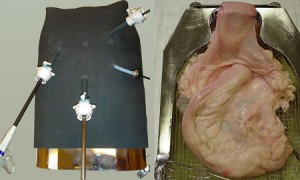University Hospital Tuebingen Department of General Surgery
December 22, 2008
University Hospital Tuebingen
Department of General Surgery
Section for Minimally Invasive Surgery
Waldhörnlestraße 22
D-72072 Tübingen
Tel.: +49 (0) 70 71 / 29 - 81233
Fax: +49 (0) 70 71 / 29 - 5569
The Section for Minimally Invasive Surgery, within the Department of General Surgery at the University of Tuebingen, is an internationally renown research centre.
The section Director, Gerhard F. Buess MD FRCSEd, has developed a whole series of various endoscopic operating techniques, for example transanal endoscopic microsurgery (TEM), now widely recognised throughout the world.
The centre figures among the leading international centres for the development of MIS. Important technological developments such as:
- Instruments with all degrees of movement
- Robotics for MIS
- Suturing systems
- Stereoscopic optical system
- Electronically linked operating system
have been conceived by the section’s researchers and developed for the market in co-operation with various development partners.
Doctors, physicists, engineers and technicians combine their talents in this section. This interdisciplinary working group also co-operates closely with various companies producing medical devices and a range of reputable research institutions.
Besides the testing of recent developments in experimental settings, the training of surgeons also plays a very important role for the Section. The only university-based training centre for MIS in Germany can be found in Tuebingen.
Research
The potential of endoscopic procedures is limited by the used imaging systems, operating instruments and devices. Therefore, our Section is searching and developing on their improvement and optimisation. New and improved technologies also allow new operative procedures. These developments are divided in areas.
As a unit of a university clinic we carry out research in the framework of public projects. Meanwhile new companies have been established continuing successfull projects, bringing products to market or transfering knowlege from the University to industry.
In R&D projects several co-operations were started with the medical care industry and research institutes various innovative instruments and devices have been developed.
The endoscopic operation
Modern endoscopic surgery today avails of two surgical methods: the operation in the abdominal cavity (laparoscopic surgery) and endoluminal surgery, which is an operation via the anus (see “TEM”).
For laparoscopic surgery, the abdominal cavity is filled with carbon dioxide. The surgical and optical instruments are inserted into the abdomen by means of thin metal cannulas. The operation is performed with the help of a video image that is transmitted by a small camera from the optical instrument (endoscope) to a monitor.
The training which we offer surgeons in our training program in Tuebingen employs an artificial abdominal wall. (Fig. 1.)

Fig. 1: Training model covered and open with inserted colon for sigma resection
Advantages of the endoscopic operation
Large incisions, which are normally necessary to gain access to the abdominal cavity, are no longer necessary with the endoscopic operation. This means less impact on bodily integrity, less pain, quicker recovery and a shorter stay at the clinic.
The abdominal cavity experiences less traumatization. Hooks and pads, which may cause minor injury to the peritoneum, are not employed. The operating table is tilted, thereby making use of the force of gravity in order to move surrounding organs out of the way.
The view of the operating region is better than with conventional operating methods because the optical instruments can be placed at optimal positions in the abdominal cavity and adjusted as needed.
Special dissection techniques have been developed which are more exact and involve less loss of blood than the techniques used in conventional surgical techniques. Blood transfusion is rarely necessary in an endoscopic operation.
Disadvantages of the endoscopic operation
Every new type of endoscopic operation must be trained extensively. For this reason we have established the first German training center in Tuebingen, where thousands of surgeons are trained in MIS. In addition, courses are offered to surgeons all over the world.
The optical instruments available today offer a good detailed view of the surgical region, but do not offer a good overview. New technology and much experience is still needed.
The insertion of the operating instruments via the trocar cannula tends to limit the motility of the instruments.We have been working on technological developments to solve this problem.
Possible complications of laparoscopic surgery
The injection of gas into the abdominal cavity and the placing of trocar cannulas give rise to new complications. These complications include bleeding, injury of organs and small tears.With experience and the correct instruments, however, these risks can be minimized and easily controlled.
Videos
Documents
Mitat Editorial Board Meeting - SMIT Wien 2008.ppt
Single Port Operation - SMIT Wien.ppt
3d without shutters - SMIT 2008.pdf
Tem aiims - New Delhi 2008.pdf
Links
e-Mail: marie.peschka@uni-tuebingen.de (Secretariat)
Internet: http://mic.uni-tuebingen.de


